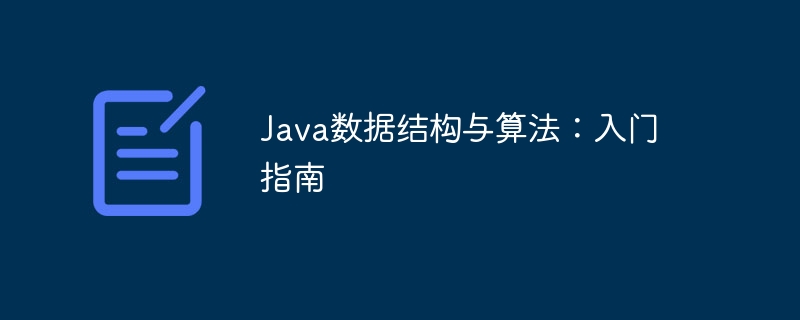Home >Java >javaTutorial >Java Data Structures and Algorithms: A Beginner's Guide
Java Data Structures and Algorithms: A Beginner's Guide
- WBOYWBOYWBOYWBOYWBOYWBOYWBOYWBOYWBOYWBOYWBOYWBOYWBOriginal
- 2024-05-09 08:57:02520browse
Data structures and algorithms in Java provide basic support for efficient and scalable programs: 1. Commonly used data structures include arrays, linked lists, stacks, queues, trees and graphs; 2. Algorithms are methodical methods for solving specific problems Step sequence, including sorting, search, dynamic programming, backtracking and greedy algorithm; 3. Data structures and algorithms can be used to solve problems in actual combat, such as finding the subarray of the specified sum through hash table and prefix sum calculation, and embodying the specific process in the code .

Java Data Structures and Algorithms: Getting Started Guide
Data structures and algorithms are the foundation of computer science and are essential for writing efficient and Scalable programs are critical. Java, as a language, provides a wide range of data structures that help programmers store and organize data efficiently. Algorithms are methods of processing and manipulating this data to solve specific problems.
Data structure
Several common data structures in Java include:
- Array: Store the same type An ordered sequence of elements.
- Linked list: Stores a collection of elements, where each element points to the next element.
- Stack: A data structure that follows the last-in-first-out (LIFO) principle.
- Queue: A data structure that follows the first-in, first-out (FIFO) principle.
- Tree: A hierarchical structure in which each node can have multiple child nodes.
- Graph: A collection of connected nodes and edges, used to represent complex relationships.
Algorithm
An algorithm is a methodical sequence of steps designed to solve a specific problem. Common algorithms in Java include:
- Sorting algorithm: Sort elements in ascending or descending order.
- Search algorithm: Find elements in the data structure.
- Dynamic programming algorithm: Decompose large problems into smaller problems and then solve them one by one.
- Backtracking algorithm: Systematically explore all possibilities and find the best solution.
- Greedy algorithm: Make a locally optimal choice at each step.
Practical Case
Let us use an example to see how to use data structures and algorithms to solve practical problems in Java:
Question: Given an array of integers, find out whether there is a subarray whose sum is the target value.
Solution:
import java.util.HashMap;
public class SubarraySum {
public static boolean subarraySum(int[] nums, int target) {
// 哈希表存储前缀和和出现次数
HashMap<Integer, Integer> map = new HashMap<>();
map.put(0, 1);
int sum = 0;
// 遍历数组
for (int num : nums) {
// 更新前缀和
sum += num;
// 检查是否有前缀和为 (sum - target)
if (map.containsKey(sum - target)) {
return true;
}
// 将前缀和添加到哈希表中
map.put(sum, map.getOrDefault(sum, 0) + 1);
}
return false;
}
public static void main(String[] args) {
int[] nums = {1, 4, 20, 3, 10, 5};
int target = 33;
boolean result = subarraySum(nums, target);
System.out.println("是否存在符合要求的子数组:" + result);
}
}Procedure:
- Use a hash table to store the prefix sum to the number of occurrences mapping.
- Traverse the array and update the current prefix sum.
- Every time the prefix sum is updated, check whether there is a prefix sum of
(sum - target), and if so, find the matching subarray. - Add the updated prefix sum to the hash table.
- After traversing the array, if the hash table does not contain any prefix sum matching
(sum - target), then there is no matching subarray.
The above is the detailed content of Java Data Structures and Algorithms: A Beginner's Guide. For more information, please follow other related articles on the PHP Chinese website!

